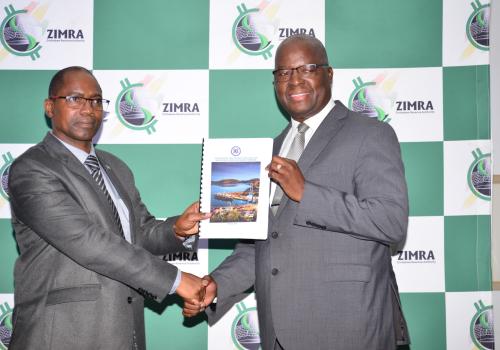In a significant step towards enhancing trade efficiency and regional integration, the Southern African Development Community (SADC) with support from the European Union (EU), under the Trade Facilitation Programme (TFP) has launched the Report of the Time Release Study (TRS) along the North South Corridor (NSC). The event took place in Harare, Republic of Zimbabwe on 7th February 2025. The TRS was developed to assist SADC Member States in addressing bottlenecks, cumbersome procedures, and uncoordinated operations among border agencies, while also tackling inadequate infrastructure. The initiative aims to reduce the cost of doing business at ports and border posts, thereby boosting intra-regional trade among SADC Member States. Commissioned by the SADC Secretariat, the report seeks to identify bottlenecks and streamline processes affecting the timely release of goods.
The TRS serves as an international model instrument to evaluate the time taken for goods transactions and clearance across the supply chain. Within the SADC region, the TRS along the North South Trade Corridor represents the first comprehensive study of this strategic route, assessing efficiency in the clearance of goods at major seaports and border posts. This extensive study provides crucial insights into the performance of customs clearance, transport, and logistics systems along the corridor, which extends from the port of Durban in South Africa to Kasumbalesa in Zambia via Beitbridge border post and Chirundu One Stop Border Post (OSBP) in Zimbabwe.
The TRS is a flagship Trade Facilitation Instrument supporting the implementation of the Regional Industrialization Strategy, anchored in the regional value chain as part of consolidating the SADC Free Trade Area, in line with the Regional Indicative Strategy Development Plan (RISDP) 2020-2030.
Mr. Batsirai Chadzingwa, Commissioner of Customs and Excise for the Republic of Zimbabwe, acknowledged the significant progress made by Member States in advancing trade facilitation along major trade corridors, which aim to enhance the welfare and well-being of citizens and consumers in the SADC Region. The primary trade corridors in the region include the North-South Corridor, the Maputo Corridor, and the Dar-es-Salaam Corridor, connecting shipping ports to industrial productivity hubs.
Mr. Chadzingwa highlighted a key finding from the report, noting that the average clearance and transit time for northbound cargo from Durban Port to Kasumbalesa is 15 days, 21 hours, and 5 minutes, and identified bottlenecks at the Beitbridge and Chirundu One-Stop Border Posts (OSBPs). He emphasised the necessity for Member States to implement coordinated border management systems, supported by robust information sharing among administrators along the corridor, to significantly enhance the efficiency of regional trade facilitation efforts. Additionally, he highlighted the importance of continuously upgrading border posts, seaports, and road infrastructure to improve trade by ensuring the effective and efficient movement and clearance of goods.
Mr. Alcides Monteiro, Senior Programme Officer for Customs and Task Manager of the European Union and SADC Trade Facilitation Programme at the SADC Secretariat, emphasised the necessity of implementing appropriate trade facilitation measures and instruments to consolidate the SADC Free Trade Area. He highlighted the TRS as an initiative that will streamline the movement of goods and services, thereby increasing competitiveness and the volume of intra-regional trade among Member States.
“In the past two years, intra-SADC trade was at 23%. While this is a fair performance, there is potential for improvement, and it would not have been achieved without the implementation of the Free Trade Area. Nonetheless, the implementation of various trade facilitation measures, both soft and hard infrastructure, holds promise for increasing trade,” he stated.
Mr. Monteiro indicated that the implementation of TRS recommendations will enhance the ease of doing business and attract foreign direct investment, enabling economies to transition from low to medium, and from medium to high, income levels.
He outlined several recommendations from the report, noting that Member States along the NSC should explore the feasibility of establishing a corridor management agency to ensure systematic and collaborative interventions. Additionally, he advocated for the implementation of a Regional Electronic Cargo Tracking System (ECTS) for all cargo moving along the corridor to prevent revenue leakages, build confidence, and expedite cargo movement.
He further stated the importance of enhancing cross-border coordination and harmonisation of processes, upgrading both physical and digital infrastructure at borders, embracing technological advancements in control and facilitation processes, and collaborating with other key stakeholders.
The event facilitated discussions of the report and enabled its handover to Member States for implementation, which will ensure the efficient movement of goods within the region, reducing trade costs, and enhancing cross-border trade facilitation measures.
The NSC study was conducted by customs and trade experts in collaboration with various supply chain stakeholders utilising the World Customs Organisation's electronic system methodology, involving port and border agencies from South Africa, Zimbabwe, Zambia, and partially the Democratic Republic of Congo (DRC). The report marks a pivotal moment for regional trade in southern Africa. By addressing the identified challenges, stakeholders can collaborate to establish a more efficient and integrated corridor, benefiting all participating nations.

